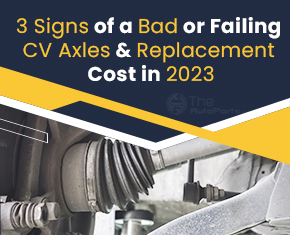Every vehicle is equipped with a mechanism for transferring engine power to the wheels. The majority of modern passenger automobiles use this system, which calls for the use of two or more constant velocity (CV) axles, with the exception of the majority of two-wheel-drive pickup trucks.
A CV axle will be defined and its workings are described in this article. We’ll focus on the common warning indications that such a system needs to be changed and discuss the associated costs.
What is a CV Axle?
A CV axle is the last shaft in a series of driveline parts that distributes power to the wheels. If your automobile has independent front and/or rear suspension and all-wheel drive, axles with constant velocity (CV) joints, also known as half shafts, are frequently utilised at all four wheels (AWD).
These drive axle types are also utilised in vehicles with independent suspension that are front-wheel drive (FWD) or rear-wheel drive (2WD).
Each CV axle will have two constant velocity joints, one at each end of the axle. These joints line up the neighbouring rotating driveline components by connecting the input and output ends of the drive axle.
By maintaining identical rotational velocities on both the input and output sides, the CV joint’s design facilitates power transfer between spinning surfaces (or velocities). As a result, the name of this section incorporates the term “constant velocity”.
Signs of a damaged CV axle
You might be able to spot growing problems with your car while driving and manoeuvring if you keep a keen eye out for it. Keep in mind that any CV axle issues are solely the result of CV joint wear out and failure because the CV axle is nothing more than a well-machined cylindrical steel bar.
The following symptoms are indicative of issues with CV axles:
1. Strange Noises at Low Speeds
Your car can make clunking, popping, or clicking noises from the right or left side when making a sharp turn at a low speed. While backing out of your garage, for instance, you could notice this when making a rapid turn to the left or right.
2. Unusual Noises When Accelerating
The same sounds are made while accelerating moderately to aggressively, especially when making even little right or left turns.
3. The steering wheel vibrates
It’s possible to feel an erratic vibration in the steering wheel while accelerating or travelling at greater speeds. This vibration might be misconstrued for an unbalanced wheel vibration.
4. Grease for tyres or wheels
A flexible boot consisting of rubber or plastic surrounds each CV joint. Grease has been crammed into this boot to lubricate the joint. As it ages, this boot might fracture or tear. The lubricant will then move quickly (flung out by centrifugal force).
Grease globs or drips on your garage floor or within a wheel or tyre will be clear signs. If they are noticed, a careful visual inspection of the appropriate CV boot is required. Any tear or break will be visible.
If you are unable to do such an examination, a quick visit to your neighbourhood service technician is advised.
What Leads a CV Axle to Break Down?
The automobile may still be drivable despite the symptoms that are typical for a CV axle that is wearing down. A totally worn-out CV axle will lock up, rendering the vehicle immobile and necessitating towing.
- Age
Almost everything degrades with time. The mechanical components of a CV axle will break after a certain number of kilometres. With typical driving, you may anticipate these devices to last for about 100,000 miles.
Axles on certain cars can endure for 200,000 miles or more. The CV axles will deteriorate much more quickly during any competition and/or off-road driving.
2. Taking a Road Through Deep Water
driving often through water that is as deep as your car’s wheel hubs, these circumstances are rare for drivers. However, such driving may permit water to enter the CV axle boots. This may cause faster wear and corrosion of CV joints.
3. CV Axle Boot Defect
A joint might lose its lube and then become exposed to abrasive road grit if the boot is split or torn. These circumstances will cause the joint to wear down quickly and mechanically fail.
Can a failing CV axle harm your differential or transmission?
Despite being uncommon, a CV axle failure that causes the axle to break might harm your car’s powertrain or differential. Such damage might significantly increase the cost of the repairs needed to get your automobile back on the road.
How Much Does It Cost to Replace CV Axle in 2023?
This is the first query to be addressed. Is it preferable to repair just the damaged CV joint rather than the complete CV axle, which would require buying two new or remanufactured CV joints?
The best solution is often to replace the complete CV axle. Even while it costs a little bit more than replacing only one CV joint, it is extremely likely that if one fails, the other will soon follow.
The cost to replace a drive axle in its entirety with a failing CV joint ranges from $150 to roughly $450. Since labour accounts for around two thirds of this expense, a knowledgeable DIYer may complete this task and save some money.
Keep in mind that the suspension connected to the problematic axle will need to be partially disassembled during the operation. The warning here is that the huge nuts and bolts on the suspension parts may be rusted and are more challenging to remove in older automobiles, especially in northern climates where winter roads are regularly salted.
It is highly advised to consult a repair handbook while maintaining your own vehicle. In addition to providing the necessary fastener torques, the repair processes will be thoroughly discussed. Also, if you really want to get the most affordable and high-quality spare parts from the leading brands at one stop , Visit The Autoparts Shop now!!
